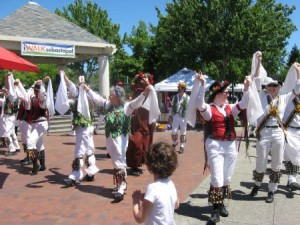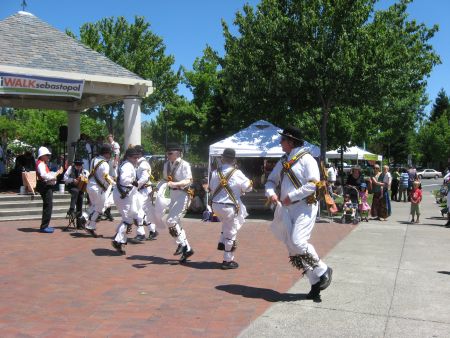 On my way to market day/I spied a morris dancer.
On my way to market day/I spied a morris dancer.
I asked her if she knew the way/And she gave me this answer,
“Not tempest tossed, nor kerchief lost/ We know not rhyme or reason
And we reckon as we beckon/ Dancing in the season.”
 Seriously, I passed a silver-haired woman in white with red and green ribbons laced around her waist, and a wreath in her hair. The costume looked familiar and I said, “Didn’t I see you dancing at May Day a couple of years ago?”
Seriously, I passed a silver-haired woman in white with red and green ribbons laced around her waist, and a wreath in her hair. The costume looked familiar and I said, “Didn’t I see you dancing at May Day a couple of years ago?”
“Not me,” she said. “I’m not from the local morris. I came up from the bay area to dance with them at the market.”
Sonoma County has its own morris, the Apple Tree Morris. Morris dancing is centuries old and is generally believed to have originated in the Cotswolds in England. The historical records don’t show mention of it, or anything like it, until about the fifteenth century. In spite of this, some partisans declare that it is Druidic or pre-Christian. Whenever or wherever it started, it is rhythmic, colorful and fun. Most morris groups dance on the equinoxes and solstices, or days like May Day.
My first introduction to the concept of morris dancing was a Ngaio Marsh murder mystery called Death of a Fool. (Apparently Marsh’s novel is the introduction for many people.) The Fool is one of the archetypal dance characters. So is the Betty, a burlesque of a woman, played by a man. This is to be expected. Apparently since prehistoric times men have had the urge to dress up like women, speak in a squeaky falsetto voice and act fake-feminine. Maybe this is genetically hard-wired, although it’s hard to see survival value in the behavior.
 I didn’t see the Fool or the Betty on Sunday, but they did have a dancing bear, which was new to me. There were at least two distinct groups; the Apple Tree Morris with their leafy green vests and another group with blue and yellow bands crossed over their torsos, looking more military. Both groups were good and they danced together. First they did a promenade through the market—which was nice, since many vendors never get to see any of the entertainment. This was the most colorful moment of the dance since both groups mingled. It is also the most musical, because the dancers wear bands of bells strapped around their calves. The liquid jingling is a counterpoint to the click of the staves or the thud of heels on pavement. The dances use staves and handkerchiefs (and in some places, I guess, swords). It looks simple, but I don’t think it is. It’s all about the timing.
I didn’t see the Fool or the Betty on Sunday, but they did have a dancing bear, which was new to me. There were at least two distinct groups; the Apple Tree Morris with their leafy green vests and another group with blue and yellow bands crossed over their torsos, looking more military. Both groups were good and they danced together. First they did a promenade through the market—which was nice, since many vendors never get to see any of the entertainment. This was the most colorful moment of the dance since both groups mingled. It is also the most musical, because the dancers wear bands of bells strapped around their calves. The liquid jingling is a counterpoint to the click of the staves or the thud of heels on pavement. The dances use staves and handkerchiefs (and in some places, I guess, swords). It looks simple, but I don’t think it is. It’s all about the timing.
 I didn’t get to see much of the dancing because I had to leave to meet Lillian in Santa Rosa. She and I had lunch at the Russian River Brewing Company. As we were finishing up, here came the troupes, still in costume, carrying fiddles and bundles of bamboo staves. Apparently morris dancing in the hot sun leads to another vital tradition; finding an air-conditioned pub and swilling down a cool brew!
I didn’t get to see much of the dancing because I had to leave to meet Lillian in Santa Rosa. She and I had lunch at the Russian River Brewing Company. As we were finishing up, here came the troupes, still in costume, carrying fiddles and bundles of bamboo staves. Apparently morris dancing in the hot sun leads to another vital tradition; finding an air-conditioned pub and swilling down a cool brew!

Pingback: All About Heirloom Tomatoes : How to Preserve Heirloom tomato Seeds | Small Garden Ideas